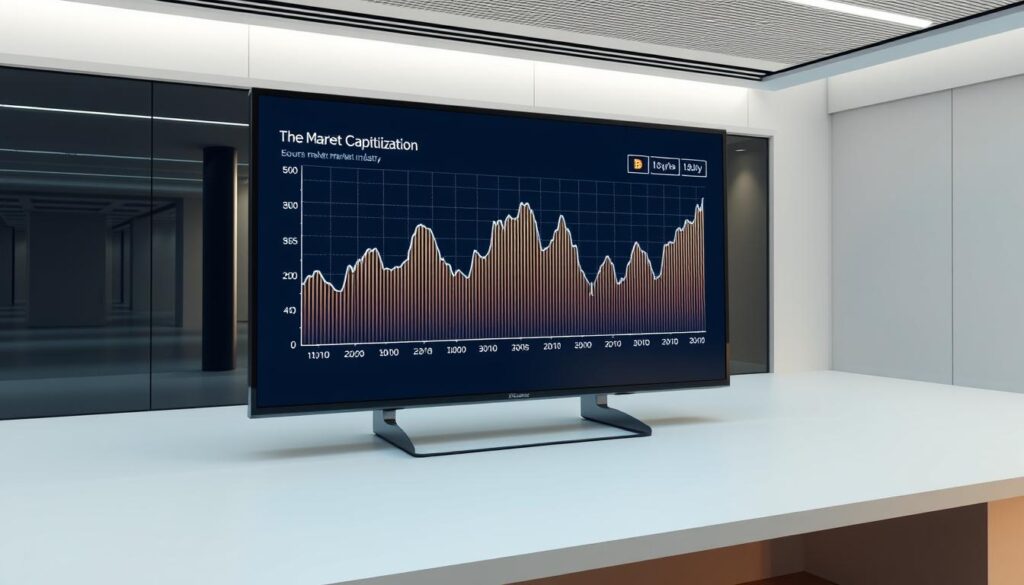Understanding Cryptocurrency Market Capitalization
Cryptocurrency market capitalization, or crypto market capitalization, is key in the financial world. It shows the total value of a cryptocurrency. The value is found by multiplying the current price of one unit by the total number of units in circulation.
This indicator measures the total value of a cryptocurrency in the market. A higher market capitalization means a cryptocurrency is more mature and widely accepted. It’s important for investors to know this, as it helps them make better choices.
For both professional and hobbyist investors, understanding cryptocurrency market capitalization is vital. The crypto market cap is a benchmark for a cryptocurrency’s health and stability. It affects investor sentiment and price.
A higher market cap usually means more stability and demand. On the other hand, smaller caps are seen as riskier because of volatility and liquidity issues. The market capitalization of popular cryptocurrencies like Bitcoin and Ethereum can change a lot due to market and economic factors.
Introduction to Crypto Market Capitalization
The formula for market capitalization is: Market Cap = Current cryptocurrency price × Total number of units outstanding. This formula gives a snapshot of a cryptocurrency’s total value. It allows for comparison among different cryptocurrencies.
The market cap shows how stable a cryptocurrency is. Higher caps usually mean more investor trust and less volatility. As the cryptocurrency market grows, understanding market capitalization is key for smart investment decisions.
Key Takeaways
- Cryptocurrency market capitalization is a vital concept in financial markets, showing a cryptocurrency’s total value.
- The market capitalization of a cryptocurrency is found by multiplying the current price by the total number of units in circulation.
- Higher market capitalization means a cryptocurrency is more mature and widely accepted.
- Understanding cryptocurrency market capitalization is essential for making smart investment choices.
- The market cap reflects stability, with higher caps indicating more investor trust and less volatility.
- Cryptocurrency market capitalization is important for both professional and hobbyist investors in the crypto world.
What Is Cryptocurrency Market Cap and Why It Matters

Cryptocurrency market capitalization, or market cap, shows how big a cryptocurrency is. It’s found by multiplying the coin’s price by its circulating supply. For example, if a coin is worth $100 and there are 25 million in circulation, its market cap is $2.5 billion.
This number tells us a lot about a cryptocurrency’s popularity and stability. It affects how much people think it’s worth and how risky it is.
The crypto market capitalization is key in figuring out a digital asset’s value. It shows how much the market trusts a cryptocurrency. A big market cap means a stable and widely used cryptocurrency, like Bitcoin.
On the other hand, smaller-cap cryptocurrencies, or altcoins, might grow faster but are riskier.
Knowing about market capitalization is important for making investment choices. It helps investors see the risk and growth chances of a cryptocurrency. Market caps are divided into large, mid, and small, each with its own risks and benefits.
By looking at the crypto market capitalization, investors can make better choices. They can understand the digital assets market size better.
The Evolution of Digital Currency Market Capitalization

The virtual currency market has seen big changes over time. The blockchain market cap has grown a lot. The market cap of a cryptocurrency shows how popular and stable it is.
Bitcoin’s market cap has grown a lot. It usually makes up 40-60% of the total market. Ethereum’s market cap is around 15-20%. The total market cap reached about $2 trillion in early 2021.
Several things have influenced the market’s growth. Decentralized finance (DeFi) protocols and non-fungible tokens (NFTs) have played a big role. Also, the use of stablecoins has grown. The shift to energy-efficient consensus mechanisms like Proof of Stake (PoS) has also affected the market cap.
The growth of digital currency market capitalization is complex. Many factors have contributed to its growth. Keeping up with the latest trends in the blockchain market cap is important.
Components of Cryptocurrency Market Cap Calculation

The market capitalization of a cryptocurrency is key for investors. It shows the coin’s value and growth chance. To find the market cap, we use two main parts: the coin’s price and the number of coins out there.
The formula is simple: Market Cap = Price per Unit x Total Coins in Circulation. For instance, if a coin costs $10,000 and there are 20 million coins, the market cap is $200 billion. This is a big number in the digital currency world.
Understanding market cap is vital for the token market cap. It tells us the total value of a cryptocurrency. The fully diluted valuation (FDV) shows what the market cap could be if all tokens were out. It’s found by multiplying the total tokens by the current price of one token.
Knowing how to calculate market cap is important for investors. It helps them see the coin’s growth chance and value. By looking at the market cap and its parts, investors can make better choices in the digital currency and token markets.
Different Types of Market Capitalization in Crypto

The cryptocurrency market cap shows a digital asset’s value and popularity. It’s divided into large-cap, mid-cap, and small-cap, based on market size. Large-cap coins have over $10 billion, mid-cap between $1 billion and $10 billion, and small-cap under $1 billion.
Investors see large-cap coins like Bitcoin and Ethereum as safer. They are less volatile than smaller coins. Mid-cap coins are more volatile but have more growth chance. Small-cap coins are very volatile and risky, but can grow fast.
Large-cap coins include Bitcoin and Ethereum. Bitcoin’s market cap is $1.34 trillion, and Ethereum’s is $425 billion. Altcoins like Tether (USDT) have a market cap of $112 billion. Knowing about these market types helps investors make better choices.
Looking at the cryptocurrency market cap is key. It helps investors understand risks and rewards. The market is always changing, with new coins and value shifts.
How Virtual Currency Market Valuation Affects Trading

The size of the digital assets market is key in figuring out the crypto market capitalization. Market capitalization is found by multiplying the current price of a cryptocurrency by the total coins mined. A bigger market capitalization usually means more stability for investors.
Bitcoin, for example, has a large market capitalization. This makes it more stable compared to other cryptocurrencies.
In the digital assets market, how prices are set is very important. This process, called price discovery, is shaped by many things. These include supply and demand, investor feelings, and market trends. Knowing about price discovery helps investors make better choices in the crypto market.
Market sentiment indicators, like trading volume and liquidity, also affect the crypto market capitalization. A high trading volume compared to market capitalization means better liquidity. This makes it easier to trade the asset.
The table below shows how market capitalization and liquidity are connected:
| Market Capitalization | Liquidity |
|---|---|
| Large-cap | High |
| Mid-cap | Moderate |
| Small-cap | Low |
In summary, the digital assets market size and crypto market capitalization are closely linked. Knowing what affects market capitalization, like price discovery and market sentiment, is key for smart investment choices in the crypto market.
Analyzing Blockchain Market Cap Trends
The blockchain market cap shows the health of the crypto market. It’s key to look at trends to make smart investment choices. The blockchain market cap changes based on supply, price, and total supply of cryptos.
Understanding the token market cap is also important. It shows the value of all tokens for a crypto. This helps investors see if a crypto might grow or stay stable.
Many things affect the blockchain market cap. For example, how cryptos are used in payments and the rules around them. Bitcoin and Ethereum’s use in apps like Cash App and PayPal has helped them stay stable. Stablecoins, like USDC, are also used more, mainly for international payments.
To really get into blockchain market cap trends, you need to look at market shares and how the market is divided. This helps investors make better choices in the complex world of crypto.
Impact of Token Market Cap on Project Viability
The cryptocurrency market cap is key to a project’s success. A high market cap shows a project’s stability and growth chances. But, a low market cap might mean more risk for investors. It’s vital for investors to understand the market cap to make smart choices.
The digital currency market cap is found by multiplying the current price by the total supply. Investors look at the market cap when checking a project’s worth. A big market cap means a project can handle market changes better.
For example, Bitcoin’s market cap is often over 40% of the total. This shows its strong position in the market. On the other hand, a small market cap might mean more risk for investors.
Project sustainability is linked to its market cap. A project with a high market cap is more likely to succeed in the long run. Investors can check a project’s sustainability by looking at its market cap to TVL ratio.
A high ratio might mean the project is overvalued. A low ratio could mean it’s undervalued. By looking at these factors, investors can make better choices about a project’s viability.
When checking a project’s market cap, consider these key points:
- Market capitalization size: large-cap, mid-cap, or small-cap
- Market cap to TVL ratio
- Project’s total supply and circulating supply
- Current market price and price history
Relationship Between Altcoin Market Cap and Bitcoin
The altcoin market cap is greatly affected by Bitcoin’s market cap. Bitcoin makes up over 60% of the total cryptocurrency market. It’s important for investors to grasp this relationship.
When Bitcoin’s dominance grows, altcoins often stay the same. But, if altcoins gain dominance, they rise, and Bitcoin’s value stabilizes.
The altcoin market cap is about $1.49 trillion, with the total market at $1.65 trillion. Bitcoin’s market cap is around $825 billion. This is based on a price of $42,000 and 19.6 million units in circulation.
The link between altcoin market cap and Bitcoin is complex. Many factors influence their market values. External factors like politics and regulations also play a role.
Some important points to remember include:
* Bitcoin’s dominance ratio often falls in bull markets or with new altcoins.
* Stablecoins have diluted Bitcoin’s dominance ratio.
* Political and regulatory influences affect BTC dominance, but their exact impact is unknown.
Understanding these points helps investors make better choices in the cryptocurrency market. They should consider both altcoin and total cryptocurrency market caps.
Market Manipulation and Capitalization Concerns
The crypto market capitalization has seen a huge jump, hitting $1 trillion in 2021. But this growth raises worries about market manipulation. Up to 90% of crypto trades might be manipulated, making the market unfair and hurting investor trust.
Manipulation tactics include fake signals and price tricks. Knowing how market capitalization is calculated, like circulating supply, is key. Rules like the Digital Commodity Exchange Act (DCEA) and Markets in Crypto Assets (MiCA) help keep the market honest.
With over 4000 coins and 300 trading venues, the digital assets market is vast. Investors need to watch out for manipulation risks. By understanding the crypto market and its factors, they can make smart choices and dodge dangers.
Regulations on digital assets vary worldwide, leading to unfair advantages. But, efforts to oversee the market are being made. The CFTC Whistleblower Program rewards tips on manipulation and protects whistleblowers from retaliation.
Global Factors Affecting Crypto Market Capitalization
The cryptocurrency market cap is shaped by many global factors. These include economic trends, regulatory environments, and technological advancements. A higher market cap is often seen as more stable for investment. It shows a larger and more established market.
The blockchain market cap is also key. It includes the market value of all blockchain-based assets. This is an important indicator of the cryptocurrency market’s health.
Several global factors impact crypto market capitalization. Economic trends like changes in interest rates and inflation affect demand. Regulatory environments play a big role, with governments either supporting or restricting cryptocurrencies. Technological advancements in blockchain and new cryptocurrencies also influence the market.
The global cryptocurrency market size was USD 910.3 million in 2021. It’s expected to reach USD 1,902.5 million by 2028, growing at 11.1% annually. This growth is driven by increasing demand, mainly in developed countries.
The cryptocurrency market cap is also influenced by digital currency adoption. This is expected to grow, affecting cross-border remittances. As the market evolves, we’ll likely see more adoption of cryptocurrencies. This will lead to further growth in the blockchain and cryptocurrency market caps.
Tools and Resources for Tracking Digital Assets Market Size
To track the digital assets market size, you need the right tools and resources. The crypto market capitalization is key to understanding the market’s health. Coinmarketcap is a top site for tracking this, showing real-time data on prices and trading volume.
For tracking, Binance, Coinbase, and Kraken are popular choices. They offer advanced trading features and strong security. Social trading platforms like eToro and BitMEX also let you trade and interact with other traders.
For deeper analysis, CoinGecko, TradingView, and CryptoCompare are great. They provide detailed data on digital currencies. This helps investors make better choices based on market trends.
Other useful tools include CoinTracker, CoinStats, and Delta. They help manage your digital assets and keep you updated on market trends. These tools are essential for investors.
- Coinmarketcap: real-time data on prices, market capitalization, and trading volume
- CoinGecko: detailed data on digital currencies
- TradingView: advanced charting tools and technical analysis indicators
- CryptoCompare: insights into trading, investing, and mining
Risk Management in Market Cap-Based Investment
Investing in the cryptocurrency market cap needs a good grasp of risk management. The market cap shows a coin’s investment value, but it’s not the only thing to look at. Data shows that market cap alone can’t tell the whole story. Investors should look at other factors, like the altcoin market cap, to make smart choices.
Having a diverse portfolio can reduce risks in the cryptocurrency market cap. This means investing in different cryptocurrencies, like Bitcoin and altcoins. It’s also important to think about how much risk you can handle and what you want to achieve with your investments. By being careful and informed, investors can aim for better returns and avoid big losses.
Key points for managing risks in market cap investments include:
* Looking at the cryptocurrency and altcoin market caps to guide your investments
* Spreading your investments to lower risks
* Thinking about your risk tolerance and goals when deciding on your portfolio
By using these strategies, investors can better understand the cryptocurrency market cap. They can make more informed choices about their investments.
Future Prospects of Cryptocurrency Market Cap
The crypto market capitalization is set to see big growth in the next few years. Experts predict the global cryptocurrency market will triple by 2030, hitting nearly $5 billion. This growth comes from more people using crypto, with 50% of internet users owning some.
Also, 47% of U.S. adults over 35 plan to invest in crypto soon. This shows a big increase in interest.
As the market grows, so does the worry about rules. Some fear new laws could change how people use crypto. This could affect the market’s nature.
Some key trends and statistics that will shape the future of crypto market capitalization include:
- 130 countries considering introducing their own central bank digital currencies (CBDCs) to compete with the cryptocurrency market
- Bitcoin’s market capitalization peaking at over $1 trillion
- Approximately 17% of U.S. adults having invested in, traded, or used cryptocurrency as of mid-2023
The future of cryptocurrency market cap is linked to the digital assets market size. As more investors join and use crypto, the market is expected to grow. This growth will be driven by new trends and tech advancements.
Conclusion: Mastering Crypto Market Cap Analysis
Cryptocurrency market capitalization is a key tool for smart investors. It helps them understand the digital asset world better. Knowing about circulating supply, current prices, total supply, and trading volume is important. This knowledge helps investors spot promising projects with a bright future.
High market cap and strong trading volume, like Bitcoin and Ethereum, show stable and established cryptocurrencies. On the other hand, low market cap with high volume might mean hype, like with meme coins. Watching these signs helps investors manage risks and succeed in the fast-changing crypto markets.
Learning to analyze cryptocurrency market cap is vital for investors. It helps them take advantage of the growth and changes in this new financial technology. By staying updated, analyzing on-chain metrics, and understanding market factors, investors can confidently make smart choices. These choices support their long-term financial goals.




